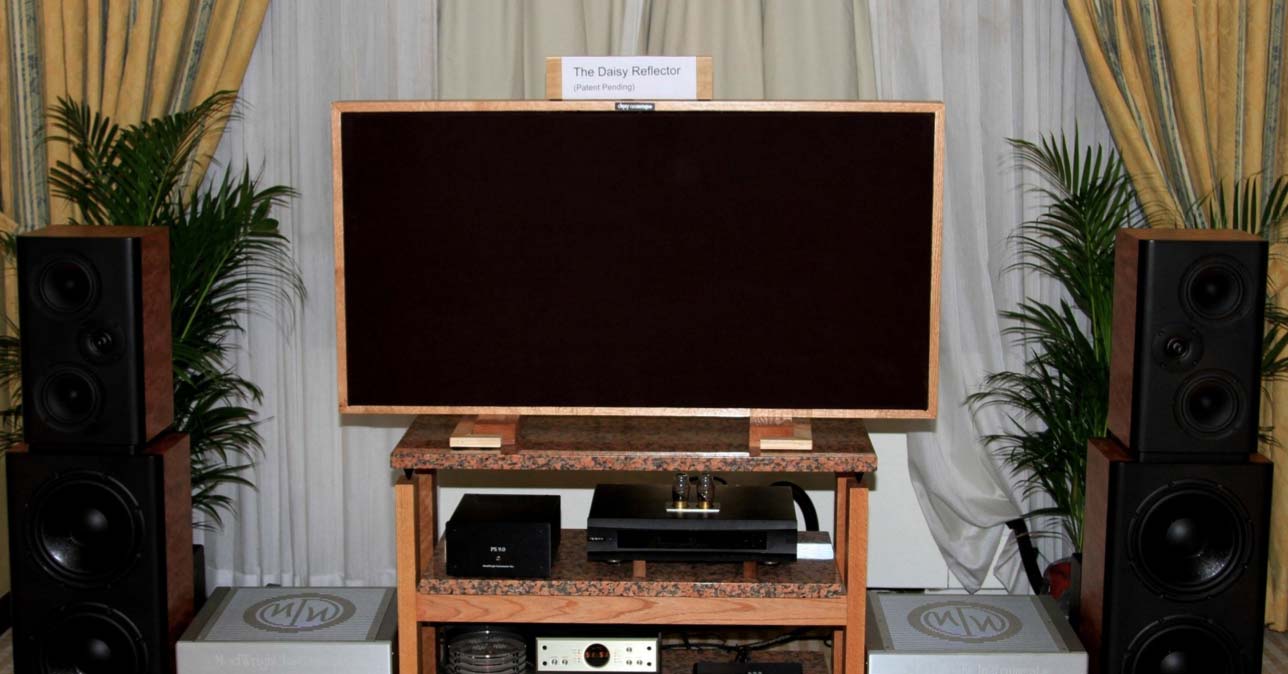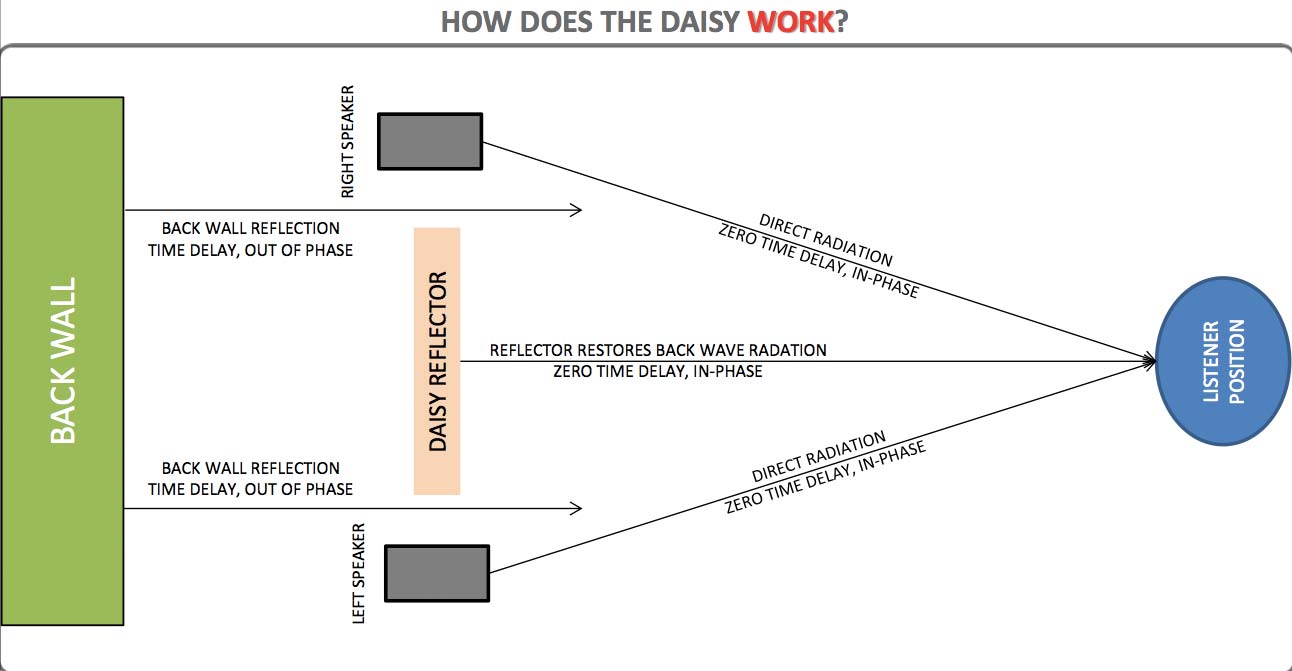As mentioned in a prior review of the Dupuy Bongo Speaker System, I had the pleasure of meeting Mr. Rudy Dupuy and his associates at the 2013 Rocky Mountain Audio Fest. At that time, Rudy introduced me to his latest product offering, the Daisy Reflector. There was actually little time to explore what the Daisy Reflector was all about during the show, but I knew from the moment I heard the system with the Daisy Reflector inserted that it was doing something interesting and not altogether bad. What exactly it was doing, I wasn’t too sure. It did not take much convincing to have Rudy agree to make a trip to sunny Florida from the frigid tundra of New York State (well, not really so much), in order to set-up and configure a Daisy Reflector in my listening room!
It bears explaining that I knew little if anything at all about the Dupuy Acoustique Daisy Reflector other than the fact that it is a passive device that is meant to act as a disruptor of unwanted or confused room reflections that serve to undermine the sound and imaging of the audio system. The theory behind this design was soon to be known to me upon Rudy’s visit.
Some of you may have seen my RMAF 2013 Show Coverage where I provided a picture of the show system. It included a massive 3-panel Daisy Reflector. In practice, Dupuy Acoustique claims that a correctly configured and placed single Daisy Reflector can be almost as effective depending upon the room and the speakers. I therefore received in house not the triple-paneled Daisy Reflector but a single panel Daisy Reflector.
It is finished in optional oak framing and a black knit grill cloth, Both front and rear are finished the same. The single Daisy Reflector in basic black framing retails for $995. It is the subject of this review.
Installation and Setup
The Daisy Reflector arrived in late November and true to his word, Rudy came to visit two weeks later to personally install it. By that time, I was well into the review period of several very interesting products that caught my attention at RMAF, so my system was a hybrid of sorts of my own reference equipment and also review gear. Rudy confidently assured me that the Daisy Reflector would make itself know in such an obvious manner that it wouldn’t matter whether I was totally familiar with the current system’s performance or not. This just made me even more anxious to see/hear what this thing actually is all about.
The day finally arrived when Rudy stopped in. Finally we could unpack this thing and get on with sorting out exactly what it is all about! I was stoked. We first unpacked the Daisy Reflector unit and bolted on its two oak feet. That is it for assembly. Feeling around inside the front and back of the black clothed unit did not reveal anything at all other than a seemingly flat hard surface. Rudy came equipped with his own tools of the trade that was all he needed to correctly place, aim, and “focus” the Daisy Reflector in any system. The predominant tool was a long piece of cotton packaging thread with a wooden clothespin tied to one end. Oy, I thought to myself. What did I just get myself into? We first placed the Dupuy Acoustique Bongo stands in strategic locations between the two Eficion F300 speakers. Then, utilizing his main measuring tool, the thread, we carefully placed the Daisy Reflector on top of the stands; carefully measuring location and distances from each speaker as well as the distance from the front baffle of the speaker. It was during this process that I realized that this simple little homemade tool enabled one person to do all of this measuring without the assistance you would generally need when utilizing a measuring tape, for instance.
For the next 30 minutes or so, I was purely a spectator/DJ/adjuster as I played the several reference CD’s that Rudy had brought with him. He sat, listened, and instructed me to make seemingly inconsequential changes to the position of the Daisy Reflector. Finally, after many of these small shifts to and fro, Rudy nodded with satisfaction.
Hearing is believing
First we listened to Rudy’s CD selections and we alternated sitting in my chair (the room’s sweet spot). Rudy complimented me on my homemade room acoustic panels and their placement. In fact, he said I had done a great job with the room. He also complimented the superb driver-matching in my Eficion F300’s as well as their speed and detail. It was then that I began to wonder if maybe the Daisy Reflector was not as “effective” as expected in my room and system.
Well as it turns out, I was dead wrong. Listening “through” the Daisy Reflector at first requires a bit of psychological adjustment. Why so? Well, because it creates the effect of a highly polished window into the recorded performance. So much so, that it first feels a bit odd to be hearing so much focused sound emanating from behind what is ostensibly a solid baffle. Is it a parlor trick? Well no. It is definitely not. In fact, we marked the specific sweet spot where the Daisy was most in focus and then purposely move it literally 1/8 of an inch either forward or backward and the focus effectively “collapsed.” Did it sound bad at that point? Well, no. It just simply was not as good. It’s like playing an LP with a dirty stylus or a CD without first cleaning it with Shin-ola.
Apparently what the Daisy Reflector is doing is correcting the time delay of the reflected waves that normally bounce from the back wall of the listening room. This is an effect that Rudy calls “Chaotic Reflections.” The Daisy then projects forward a time-aligned refection of its own. This very alignment is why the sound changes so dramatically with the very small changes in location. I’m guessing that the closer you get to aligning the Daisy Reflector to the voice coil of the speaker drivers, the closer to time alignment you get. Whatever the science is, I can tell you that the differences are astoundingly audible.
After Rudy’s departure, I kept the Daisy Reflector in place and experimented quite a bit with placement and its effectiveness at restoring image size and clarity are amazing. Is the difference earth-shattering? No. This is why the comment about my efforts at taming my sound room. Indeed by all counts I already have a darn good room with little left to “tame” through absorption. However, even in this case, the Daisy Reflector proved to be an effective improvement. The more I think about this clever device, the more I realize its wide applicability outside of a dedicated two-channel environment. Even still, in a dedicated two-channel setting whether acoustics are a challenge or not, using more of these devices say, to both sides of the speakers and the “full monty” three-panel-tower Daisy Reflector (as was utilized at the audio show) would enable anyone to literally focus the sound of their system to a sweet spot regardless of the challenges offered by the rooms acoustics. A very fascinating approach to a damning problem most everyone faces in one way shape or form.
Conclusion
The Daisy Reflector is a refreshingly new idea that treads uncharted territory: the simulation of movable walls in order to achieve time alignment at the listening position. The applicability of this concept is endless if it were available in other form factors. Even as it stands today, I’m sure there are many audiophiles who have fought the demons of room reflections, windows, and other acoustical nightmares. I believe that in all cases, minor to severe, the Daisy Reflector offers a truly unique and effective passive solution that enables you to listen to your system and not your room. As such, I recommend this device as a valuable room correction tool and in some cases, as a full on system component.
- (Page 1 of 1)


